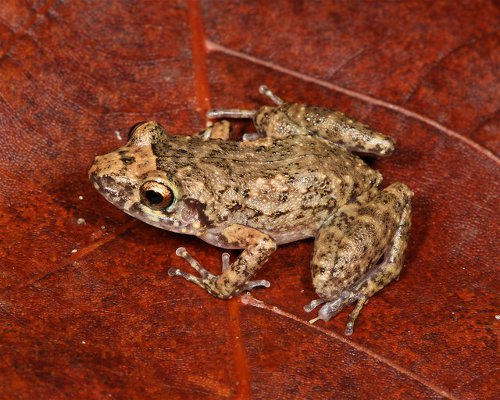EDRR Invasive Species
Greenhouse Treefrog (Eleutherodactylus planirostris)
Define Invasive Species: must have ALL of the following –
- Is non-native to the area, in our case northwest Florida
- Introduced by humans, whether intentional or accidental
- Causing either an environmental or economic problem, possibly both
Define EDRR Species: Early Detection Rapid Response. These are species that are either –
- Not currently in the area, in our case the Six Rivers CISMA, but a potential threat
- In the area but in small numbers and could be eradicated
Native Range:
Greenhouse treefrog is native to Cuba, the Cayman Islands, and the Bahamas.
Introduction:
The Greenhouse treefrog may have been accidentally introduced on shipments of tropical plants from the Caribbean. Another study suggest it may have drifted across from Cuba on debris. The earliest record is from 1863 in the Florida Keys.
EDDMapS currently list 924 records of the Greenhouse treefrog. EDDMapS records include 22 counties in Florida and 2 in Georgia. However, the USGS reports records from 49 geographic locations in Florida, 8 in Louisiana, 6 in Hawaii and Alabama, 5 in Georgia, 2 in Mississippi and 1 each in Guam, Missouri, Oklahoma, and Texas.
EDDMapS records within Six Rivers CISMA include Escambia and Okaloosa counties. The USGS records include records in Okaloosa, Santa Rosa, and Escambia counties.
Description:
This is a small frog reaching lengths of only 1.25”. Reddish brown to bronze in color with dark blotches over the body. There may be a dark triangle or chevron pattern between the red eyes. The toes are long and thin and tipped with tiny toe pads and lack webbing.
Issues and Impacts:
The impact of this non-native is still unclear. The species has been a resident in Florida for over 100 years with no noticeable impacts. It has been found co-habitating with some native species. There is some concern in Hawaii and Guam, but local impacts seem to be minimal.
Management:
With little or no negative impact, management recommendations are not provided, and maybe not be needed. If you are having a problem with this species, contact your local county extension office for advice.
References
Johnson, S.A. 2020. Florida’s Frogs and Toads. The Greenhouse Treefrog (Eleutherodactylus planirostris). Johnson Lab, University of Florida Department of Wildlife Ecology and Conservation. https://ufwildlife.ifas.ufl.edu/frogs/greenhousefrog.shtml.
The Greenhouse Treefrog (Eleutherodactylus planirostris). University of Florida Extension. https://wec.ifas.ufl.edu/extension/wildlife_info/frogstoads/eleutherodactylus_planirostris_planirostris.php.
Partymiller, L. The Greenhouse Treefrog (Eleutherodactylus planirostris). Savannah River Ecology Laboratory. University of Georgia. https://srelherp.uga.edu/anurans/elepla.htm.
Somma, L.A., 2022, Eleutherodactylus planirostris (Cope, 1862): U.S. Geological Survey, Nonindigenous Aquatic Species Database, Gainesville, FL, https://nas.er.usgs.gov/queries/FactSheet.aspx?speciesID=61, Revision Date: 5/31/2019, Access Date: 4/11/2022. https://nas.er.usgs.gov/queries/FactSheet.aspx?speciesID=61.
Early Detection and Distribution Mapping System (EDDMapS)
Six Rivers CISMA
https://www.floridainvasives.org/sixrivers/
- Our Environment: Part 11 – We Need Water - July 7, 2025
- Our Environment: Part 10 – Improving Agriculture - June 20, 2025
- Marine Creatures of the Northern Gulf – Snails and Slugs - June 20, 2025

